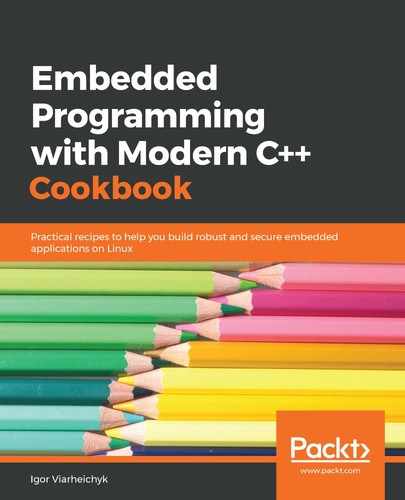In this recipe, we will learn how to use a Linux shared memory API for data exchange between two or more applications:
- In your working ~/test directory, create a subdirectory called shmem.
- Use your favorite text editor to create a shmem.cpp file in the shmem subdirectory. Define the SharedMem class, starting with common headers and constants:
#include <algorithm>
#include <iostream>
#include <chrono>
#include <thread>
#include <sys/mman.h>
#include <fcntl.h>
#include <unistd.h>
const char* kSharedMemPath = "/sample_point";
const size_t kPayloadSize = 16;
using namespace std::literals;
template<class T>
class SharedMem {
int fd;
T* ptr;
const char* name;
public:
- Then, define a constructor that does most of the work:
SharedMem(const char* name, bool owner=false) {
fd = shm_open(name, O_RDWR | O_CREAT, 0600);
if (fd == -1) {
throw std::runtime_error("Failed to open a shared memory region");
}
if (ftruncate(fd, sizeof(T)) < 0) {
close(fd);
throw std::runtime_error("Failed to set size of a shared memory
region");
};
ptr = (T*)mmap(nullptr, sizeof(T), PROT_READ | PROT_WRITE,
MAP_SHARED, fd, 0);
if (!ptr) {
close(fd);
throw std::runtime_error("Failed to mmap a shared memory region");
}
this->name = owner ? name : nullptr;
std::cout << "Opened shared mem instance " << name << std::endl;
}
- Add the definition of the destructor:
~SharedMem() {
munmap(ptr, sizeof(T));
close(fd);
if (name) {
std::cout << "Remove shared mem instance " << name << std::endl;
shm_unlink(name);
}
}
- Finalize the class definition with a small method that returns a reference to the shared object:
T& get() const {
return *ptr;
}
};
- Our SharedMem class can work with different data types. Let's declare a custom data structure that we want to use:
struct Payload {
uint32_t index;
uint8_t raw[kPayloadSize];
};
- Now add code that writes data to the shared memory:
void producer() {
SharedMem<Payload> writer(kSharedMemPath);
Payload& pw = writer.get();
for (int i = 0; i < 5; i++) {
pw.index = i;
std::fill_n(pw.raw, sizeof(pw.raw) - 1, 'a' + i);
pw.raw[sizeof(pw.raw) - 1] = '�';
std::this_thread::sleep_for(150ms);
}
}
- Also, add code that reads data from the shared memory:
void consumer() {
SharedMem<Payload> point_reader(kSharedMemPath, true);
Payload& pr = point_reader.get();
for (int i = 0; i < 10; i++) {
std::cout << "Read data frame " << pr.index << ": " << pr.raw << std::endl;
std::this_thread::sleep_for(100ms);
}
}
- Add the main function to tie everything together, as shown in the following code:
int main() {
if (fork()) {
consumer();
} else {
producer();
}
}
- Create a file called CMakeLists.txt in the loop subdirectory with the following content:
cmake_minimum_required(VERSION 3.5.1)
project(shmem)
add_executable(shmem shmem.cpp)
target_link_libraries(shmem rt)
set(CMAKE_SYSTEM_NAME Linux)
set(CMAKE_SYSTEM_PROCESSOR arm)
SET(CMAKE_CXX_FLAGS "--std=c++14")
set(CMAKE_CXX_COMPILER /usr/bin/arm-linux-gnueabi-g++)
- Build the application and copy the resulting executable binary to the target system. Use recipes from Chapter 2,Setting Up the Environment, to do it.
- Switch to the target system terminal. Log in using user credentials, if needed.
- Run the binary.
